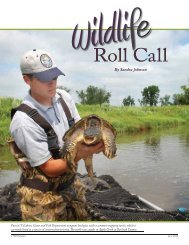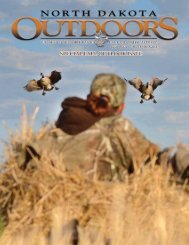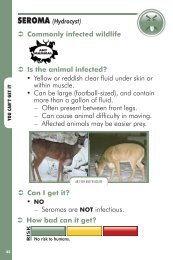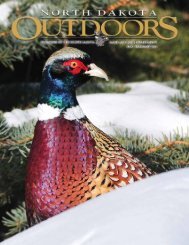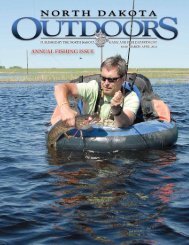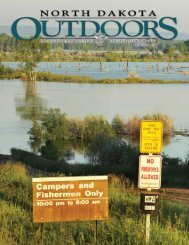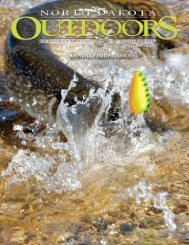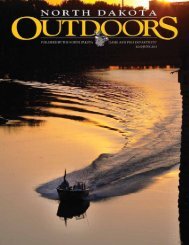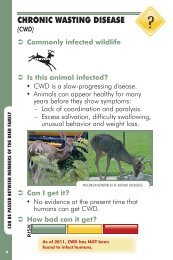March_April 2013.pdf - North Dakota Game and Fish
March_April 2013.pdf - North Dakota Game and Fish
March_April 2013.pdf - North Dakota Game and Fish
- No tags were found...
You also want an ePaper? Increase the reach of your titles
YUMPU automatically turns print PDFs into web optimized ePapers that Google loves.
River – A strong catfish population, withsome fish exceeding 10 pounds. This iswhere anglers will find the best chanceto catch a big cat in the Missouri RiverSystem. Anglers who target the area fromWilliston to the Missouri River <strong>and</strong> YellowstoneRiver confluence are generallyquite successful during the open water season,<strong>and</strong> fair numbers of catfish are caughtthrough the ice.Lake Sakakawea – Good population ofcats throughout the reservoir, but the bestnumbers <strong>and</strong> fishing success are in theupper end. Catfish abundance in LakeSakakawea generally increased during thelast drought <strong>and</strong> likewise began to increaseagain in 2012 due to declining lake elevations.Garrison Dam Tailrace – Provides somegood fishing for smaller catfish, especiallyin summer. Cats from this area are greattable fare thanks to relatively cold waterthroughout summer.Missouri River, south of GarrisonDam – Catfish are abundant in this reach,<strong>and</strong> good fishing often occurs around themouths of tributaries <strong>and</strong> well upstreamduring good flow conditions.SALMONMissouri River System – The MissouriRiver salmon fishery was greatly affectedby high water in 2011, but recovereddramatically in 2012. Salmon fishing onLake Sakakawea was exceptional last year,with an abundance of quality-sized fishharvested by anglers.While habitat conditions <strong>and</strong> forageabundance remain good, the quality of theLake Sakakawea salmon fishery in 2013is unknown. Salmon stocked during the2011 flood will be the dominant portionof salmon available to anglers in 2013.However, it is unknown to what extentthose young salmon were flushed throughGarrison Dam. High entrainment of adultsalmon was experienced in 2011, but fishingstill proved good in 2012. Hopefully,that trend continues this year.WHITE BASSMissouri River System – Lake Oahetypically has a much better white bassfishery than Lake Sakakawea. White bass,however, experienced a severe die-off inOahe a few years ago <strong>and</strong> have not fullyrecovered. Natural reproduction wasexceptional in 2009, but a large die-offof young bass was also reported. Overall,white bass abundance remains well belowpast levels.SMALLMOUTH BASSLake Sakakawea – Similar to northernpike, smallmouth bass abundance declineddue to low water <strong>and</strong> poor spawning habitat.However, reproduction was exceptionalbeginning in 2008, <strong>and</strong> anglers have beenencountering good numbers of fish in thelast couple of years.In 2012, anglers caught a high numberof Whopper-sized smallmouth bass fromLake Sakakawea. Abundance <strong>and</strong> size ofsmallmouth should remain exceptional in2013.TROUTGarrison Dam Tailrace continues toproduce trophy brown, rainbow <strong>and</strong> cutthroattrout. Rainbow trout have doneespecially well, with good numbers of 5- to10-pound fish caught by anglers.The Tailrace brown trout fishery hasslowed in recent years, but still containsworld-class-sized fish. A 20-pound brownis always a possibility.Cutthroat trout have not done quite sowell in recent years. Following their initialboom in the early 2000s, the populationhas declined in numbers <strong>and</strong> qualitydespite continued stocking.DEVILS LAKE BASINR<strong>and</strong>y Hiltner, district fisheries supervisor,<strong>and</strong> Todd Caspers, fisheries biologist, bothDevils LakeWALLEYEDevils Lake – Continues to support alarge walleye population. Most of the fishare less than 16 inches. The past severalyears of excellent reproduction have producedmany fish that are now 8-16 inches.Larger fish are available, but at lowerdensities than several years ago, partiallybecause of low walleye reproduction from2003-05.Devils Lake’s walleye population continuesto thrive, with significant naturalreproduction <strong>and</strong> periodic small stockings.<strong>Fish</strong>ing opportunities will extend into thefuture as good densities of young fish arebeing recruited into the fishery.Stump Lake – A good population of walleye,most are less than 18 inches.Lake Irvine – Good numbers of walleye,with most under 20 inches.NORTHERN PIKEDevils Lake – As water levels rise, theupper regions of the lake have exp<strong>and</strong>ed<strong>and</strong> provided excellent spawning habitat.As a result, pike natural reproduction hasbeen high the past several years.There will be great pike fishing opportunitiesin 2013. Pike can save a slow dayof fishing as they are willing biters, especiallyin spring. <strong>Fish</strong> can be found lakewide<strong>and</strong> most are between 20-30 inches,but there are some larger pike as well.Stump Lake – Pike are common. Goodnumbers of medium- to larger-sized fishas well.Lake Irvine – High numbers of mediumsizedpike. While most fish are under 5pounds, there are some larger pike as well.YELLOW PERCHDevils Lake – Perch densities have slowlyincreased as a result of two strong hatchesin 2006-07 <strong>and</strong> 2011. Population sizestructure is somewhat top heavy withbigger fish because of limited hatchingsuccess in recent years.However, the 2011 hatch looked strong<strong>and</strong> these fish did show up in the 2012survey as 5-6 inchers, so future recruits arepresent. Perch fishing should be good thiscoming winter, but not as good as the lastboom of the late 1990s <strong>and</strong> early 2000s.Stump Lake – Perch population is increasing,with good numbers of medium-sizedfish, with some big fish, too.Lake Irvine – Yellow perch numbers arelow, but the few perch in the lake aregood-sized.WHITE BASSDevils Lake – White bass densities havedecreased from a recent high in 2008.However, bass are still common <strong>and</strong> manyare 14 inches or longer.Stump Lake – White bass are currently atlow densities.Lake Irvine – Numbers are low, but likeperch, the few white bass in the lake aregood-sized.<strong>March</strong>-<strong>April</strong> 2013 ND Outdoors 23



